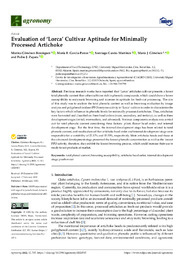Por favor, use este identificador para citar o enlazar este ítem:
https://hdl.handle.net/11000/35975Registro completo de metadatos
| Campo DC | Valor | Lengua/Idioma |
|---|---|---|
| dc.contributor.author | GIMÉNEZ BERENGUER, MARINA | - |
| dc.contributor.author | García Pastor, María Emma | - |
| dc.contributor.author | García Martínez, Santiago | - |
| dc.contributor.author | Giménez, María José | - |
| dc.contributor.author | Zapata, Pedro J | - |
| dc.contributor.other | Departamentos de la UMH::Biología Aplicada | es_ES |
| dc.date.accessioned | 2025-03-14T08:49:37Z | - |
| dc.date.available | 2025-03-14T08:49:37Z | - |
| dc.date.created | 2022-02-18 | - |
| dc.identifier.citation | Agronomy 2022, 12(2), 515 | es_ES |
| dc.identifier.issn | 2073-4395 | - |
| dc.identifier.uri | https://hdl.handle.net/11000/35975 | - |
| dc.description.abstract | Previous research works have reported that ‘Lorca’ artichoke cultivar presents a lower total phenolic content than other cultivars rich in phenolic compounds, which could show a lower susceptibility to enzymatic browning and increase its aptitude for fresh-cut processing. The aim of this study was to analyze the total phenolic content as well as browning evaluation by image analysis and polyphenol oxidase (PPO) enzyme activity in ‘Lorca’ cultivar in order to characterize the key factors which influence its phenolic levels for minimally processed artichokes. Thus, artichokes were harvested and classified on three head orders (main, secondary, and tertiary), as well as three development stages (initial, intermediate, and advanced). Variance components analysis was carried out for total phenolic content considering three factors: plant, flower head order, and internal development stage. For the first time, the internal development stage has been related to total phenolic content, and results showed that artichoke head order and internal development stage were responsible for a variability of 22.17% and 15.55%, respectively. Main artichoke heads and those at the advanced development stage presented the lowest phenolic concentration as well as the lowest PPO activity; therefore, they exhibit the lowest browning process, which could increase their use in ready-to-eat products at market | es_ES |
| dc.format | application/pdf | es_ES |
| dc.format.extent | 12 | es_ES |
| dc.language.iso | eng | es_ES |
| dc.publisher | MDPI | es_ES |
| dc.rights | info:eu-repo/semantics/openAccess | es_ES |
| dc.rights | Attribution-NonCommercial-NoDerivatives 4.0 Internacional | * |
| dc.rights.uri | http://creativecommons.org/licenses/by-nc-nd/4.0/ | * |
| dc.subject | Total phenol content | es_ES |
| dc.subject | Browning susceptibility | es_ES |
| dc.subject | Artichoke head order | es_ES |
| dc.subject | Internal development stage | es_ES |
| dc.subject | Postharvest | es_ES |
| dc.title | Evaluation of ‘Lorca’ Cultivar Aptitude for Minimally Processed Artichoke | es_ES |
| dc.type | info:eu-repo/semantics/article | es_ES |
| dc.relation.publisherversion | https://doi.org/10.3390/agronomy12020515 | es_ES |

Ver/Abrir:
agronomy-12-00515 Lorca 2022.pdf
1,14 MB
Adobe PDF
Compartir:
 La licencia se describe como: Atribución-NonComercial-NoDerivada 4.0 Internacional.
La licencia se describe como: Atribución-NonComercial-NoDerivada 4.0 Internacional.
.png)